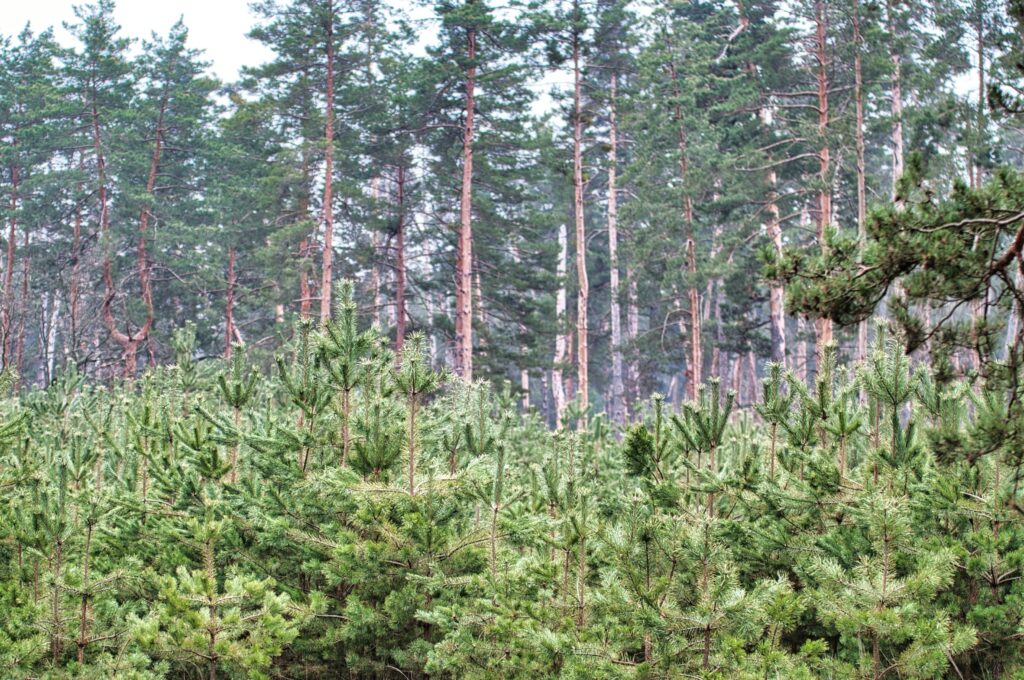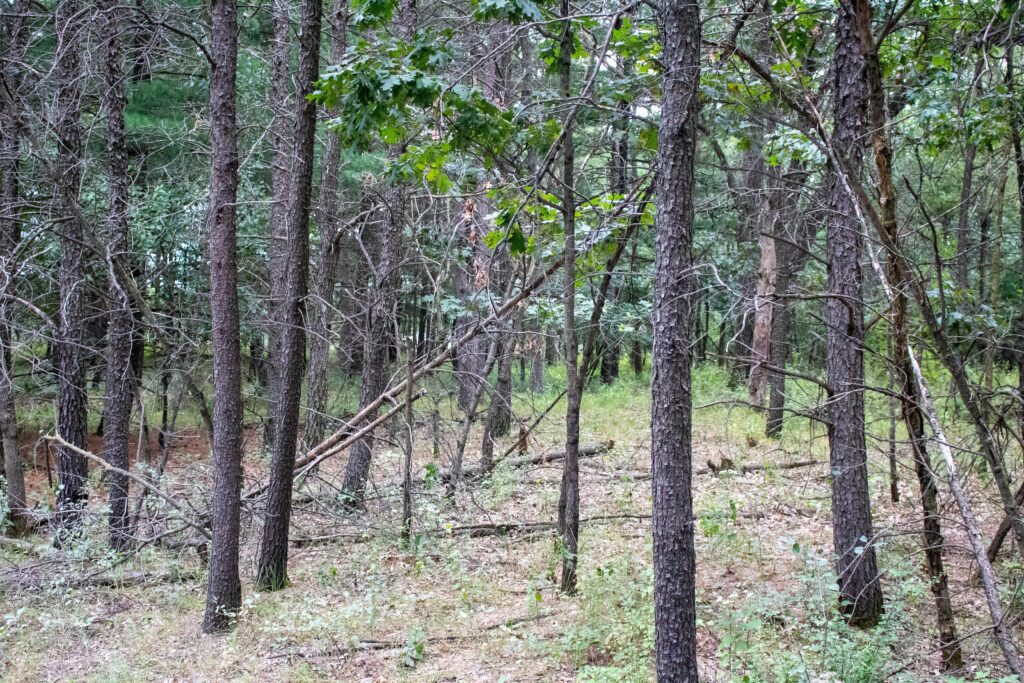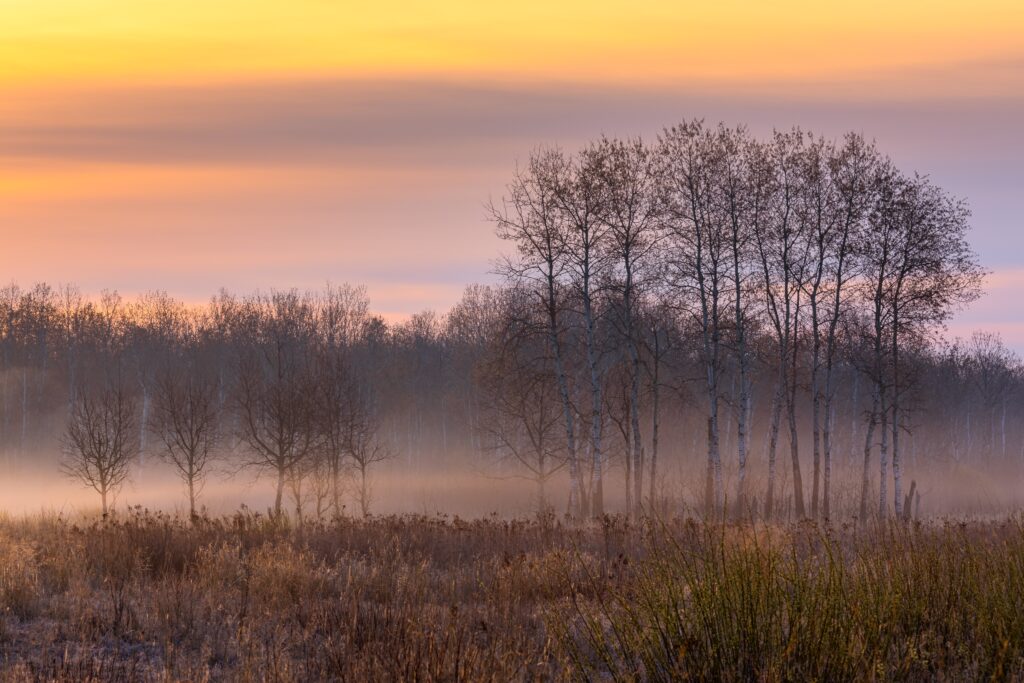
Woodlot Regeneration For WI Landowners
By Denise Thornton
Whether you are managing woods that have been in your family for generations, or just getting to know your new property, it’s best to have realistic goals that take the long view. The first step is to understand what trees you have, their condition, and where they are in their natural life cycle.
“A common misconception is that trees seem permanent, and if we just leave our forest alone, it will stay that way forever,” says forester and WDNR Forest Products Specialist, Brian Zweifel. “But all trees have a known life span, and as they age, they don’t produce as much viable seed. The ability of trees to fight off root rot, disease, and insect attacks also begins to decline with age. If spongy moth defoliates a young, healthy tree multiple years in a row, it may recover, but an older tree is more likely to be killed by that kind of defoliation. Even if a tree survives such a crisis, another organism that is attacking at the same time can put the nail in its coffin.”
When the canopy trees start to decline and die, that changes the amount of light reaching the forest floor, and invasives like buckthorn, honey suckle, and multiflora rose can take up that space and keep light from reaching any desirable native species that may be down there trying to renew the lost cover.

There are a number of different practices to choose from or apply in combinations that can help restore a forested area. “Silviculture is not just managing for timber products,” says WDNR Forest Ecologist/Silviculturist Brad Hutnik. “We can manage for any product. It could be Cerulean Warblers, clean water, or morels. No matter the end, the first step is identifying goals and objectives.”
That’s where a forester can assist in refining your objectives and opportunities. They can help determine what you have now, its condition, and the maturity of your woods. With that information, a forester can then offer treatments to make sure you have a healthy forest into the future.
Sometimes that means being honest with ourselves about what is realistic. “We start out as purists and wind up as realists,” says Hutnik. “We might want to go back to pre-settlement conditions, but we often have to adapt to what we have and what we can accomplish. In ecological restoration we think about putting all the pieces back in place, but in some situations it might be better to consider what forces are shaping a forest now, and how to work with that.”
“We have a forest cover type in Wisconsin termed Central Hardwood Forest,” Hutnik continues. “It’s a novel condition because it did not occur in Southern Wisconsin to any large extent prior to European settlement. The Central Hardwood cover type is not dominated by maple or oak. It’s typical of woods that were predominantly oak savannas, woodlands, and forests, but due to past management haven’t regenerated to oak. With few sugar or red maple seed sources present, these stands consist primarily of species like black cherry, shagbark and butternut hickory, American elm, slippery elm and hackberry. When we look back thousands of years, these species were not predominant on the sites where they are now. Restoration in this context will be informed by the past, but will look different than the past.”
Throughout the state, oak is not regenerating well on rich sites. On drier sites such as those found in Central Wisconsin, we can regenerate oak, however in areas like the Driftless Area, oak is getting a lot of competition from other vegetation. According to the White Oak Initiative, “Without action, American white oak forests will disappear in a generation with significant impacts on wildlife, forest ecosystems, and timber supplies.” Among other losses that would come from this decline, only white oak has the property of naturally plugging its root-to-leaf vessels when they are no longer being used to transport water — naturally reducing their vulnerability to fungus and decay. “That’s why we use white oak barrels for whisky and wine production and boat hulls. If you build a barrel out of any other wood, the liquid will seep out,” says Zweifel.

Pre-settlement oak stands in Southern Wisconsin were originally managed by fire. Then, since the late 1800s, they were heavily grazed. Cattles’ tendency to disturb the root systems and inadvertently kill off the bigger, more mature trees was great for creating the oak stands that are here now, Zweifel notes. “Oak tends to need a fair amount of disturbance to provide ideal reproductive conditions. Now that we don’t have as many cattle on the landscape, we are trying to use fire to help oaks regenerate better.”
Other practices used to regenerate wood lots include:
Thinning: A cultural treatment made to reduce stand density of trees primarily to improve growth and enhance forest health. Zweifel says, “We have all seen a piece of wood where the rings are really tiny and then all of a sudden they get huge – that was probably after thinning. Stands can stagnate when they are too crowded. If you select the healthiest and best trees for your objectives and remove the others, they will get bigger faster.”
Shelterwood Regeneration: A silvicultural method designed to regenerate a stand by manipulating the overstory and understory to create conditions favorable for the establishment and survival of desirable tree species. Removing 50 to 60 percent of the overstory so when you look up, partially open sky allows dappled sunlight to hit the forest floor, while still supplying an ample seed source from the remaining trees. This is ideal for regenerating oak. In Northern Wisconsin, shelter woods are particularly useful. Once the young oaks are established, then you take out the majority of the overstory trees, leaving pockets of mature trees for diversity and habitat. In Southern Wisconsin and the Driftless Area especially, the shelter woods technique is less practical because it requires multiple entries, and may not be cost effective on steep ground.
Mid-story Removal: To set the stage for oak restoration, removing trees in the shade of mature oaks, like hickory, elms, cherries, and even some of the shrubs, can be effective.
Patch Clear Cuts: A clear cut of about one half to two acres created in the overstory to open an area to full sun and a mix of light around the edges can be used to regenerate species like oak, hickory, and other hardwoods in areas where it is difficult to operate.
Single Tree Selection: For shade-adapted species like maple – you can take out a tree or two here and there and open a canopy gap to allow young trees waiting underneath to capture that space.
“Silviculture is mimicking natural processes that have worked for millennia,” says Zweifel. “Foresters benefit from spending a lot of time and getting a lot of practice on different sites with different goals. The science part of silviculture is gathering information, and then there is the art of knowing when and where to apply it.”
Climate change is also a consideration today, and there are tools now that allow us to look at a particular tree species and project whether the species as a whole will do well or not with the changes predicted for Wisconsin. You can learn more at Climate Change Projections for Tree Species in the Northwoods (MN, WI, MI)
“A big part of our foresters’ work load is getting calls from land owners, then doing a walk through, and talking about their goals and options,” says Zweifel. “And if you want to do a full management plan (basically an instruction manual for practices to meet your objectives), you will need to hire a private consulting forester.” You can use the WDNR forestry assistance locator. Enter your county, and it will provide a list of WDNR foresters as well as private consulting foresters who work in your county.

The WDNR foresters and private consulting foresters can give landowners a number of options for funding assistance opportunities. These funds are set aside for private landowners who have approved management plans in place, and you can apply through the Wisconsin Forest Landowner Grant Program . “I’ve seen it used to build access roads to make it easier to treat invasives, or to do a timber harvest,” Zweifel says.
“What we need for the future,” says Hutnik, “ is a model for a working oak woodland with a diversity of age classes and size classes and densities within the stand. We need to encourage landowners to tinker a bit. We really don’t have all the answers yet.”
“Woods don’t work on our time scale, so we have to adapt to theirs,” Hutnik says. “We have to recognize that these trees may live for hundreds of years. You are setting the stage for future landowners who will see the benefit and continue to manage your woods. In the here and now, you’ll know that the improvements you make in the ability of your woods to perpetuate itself is just good forestry.”
